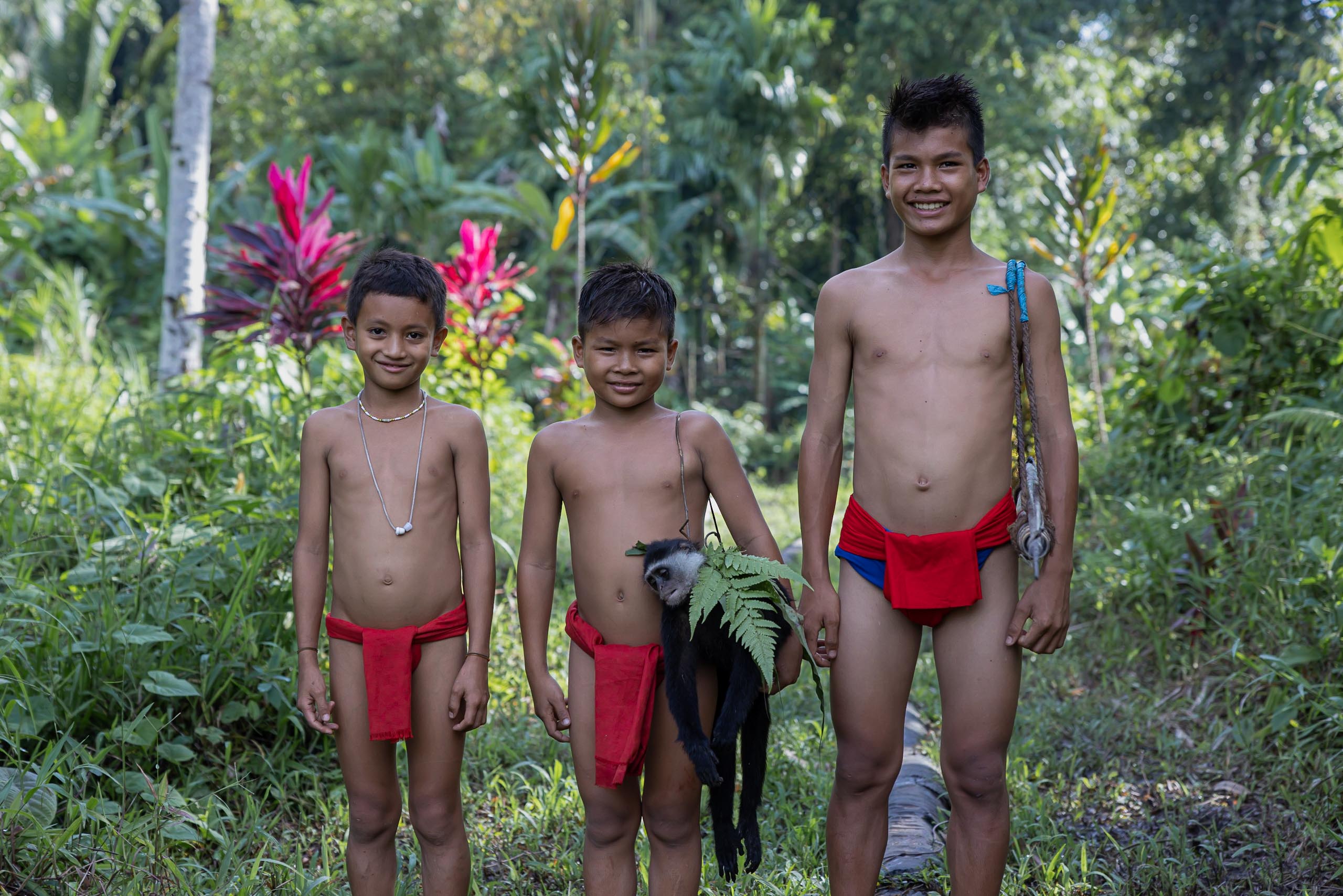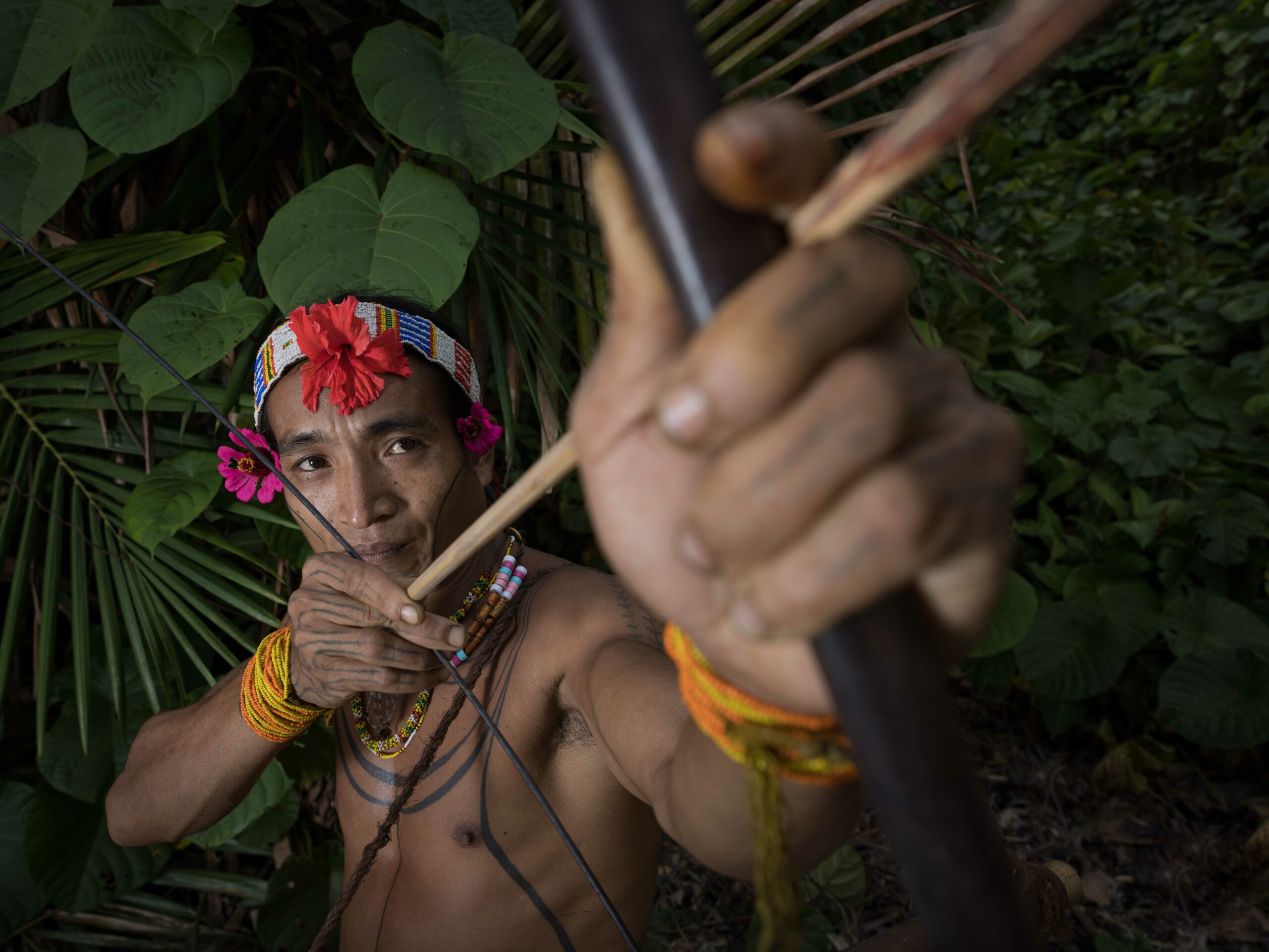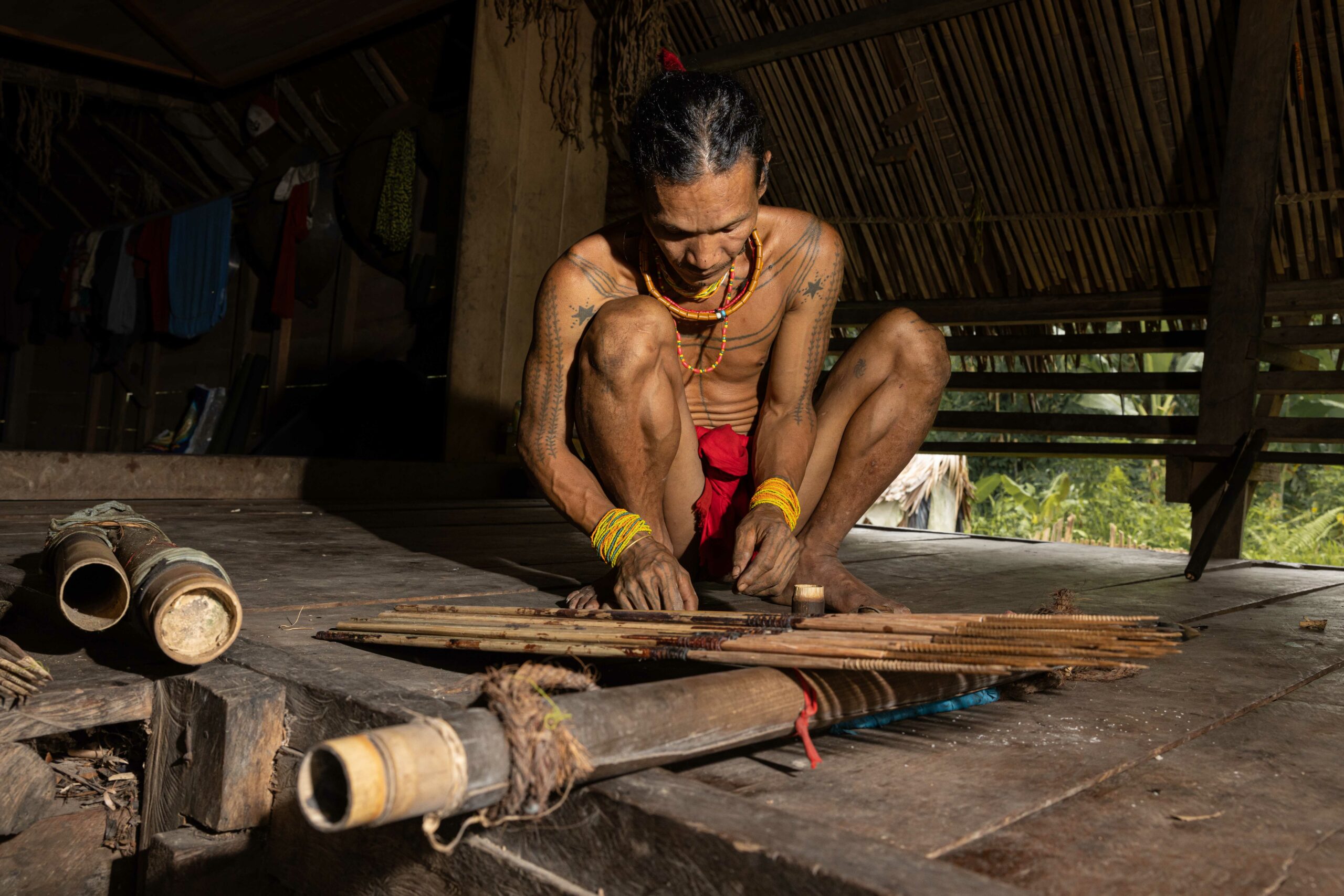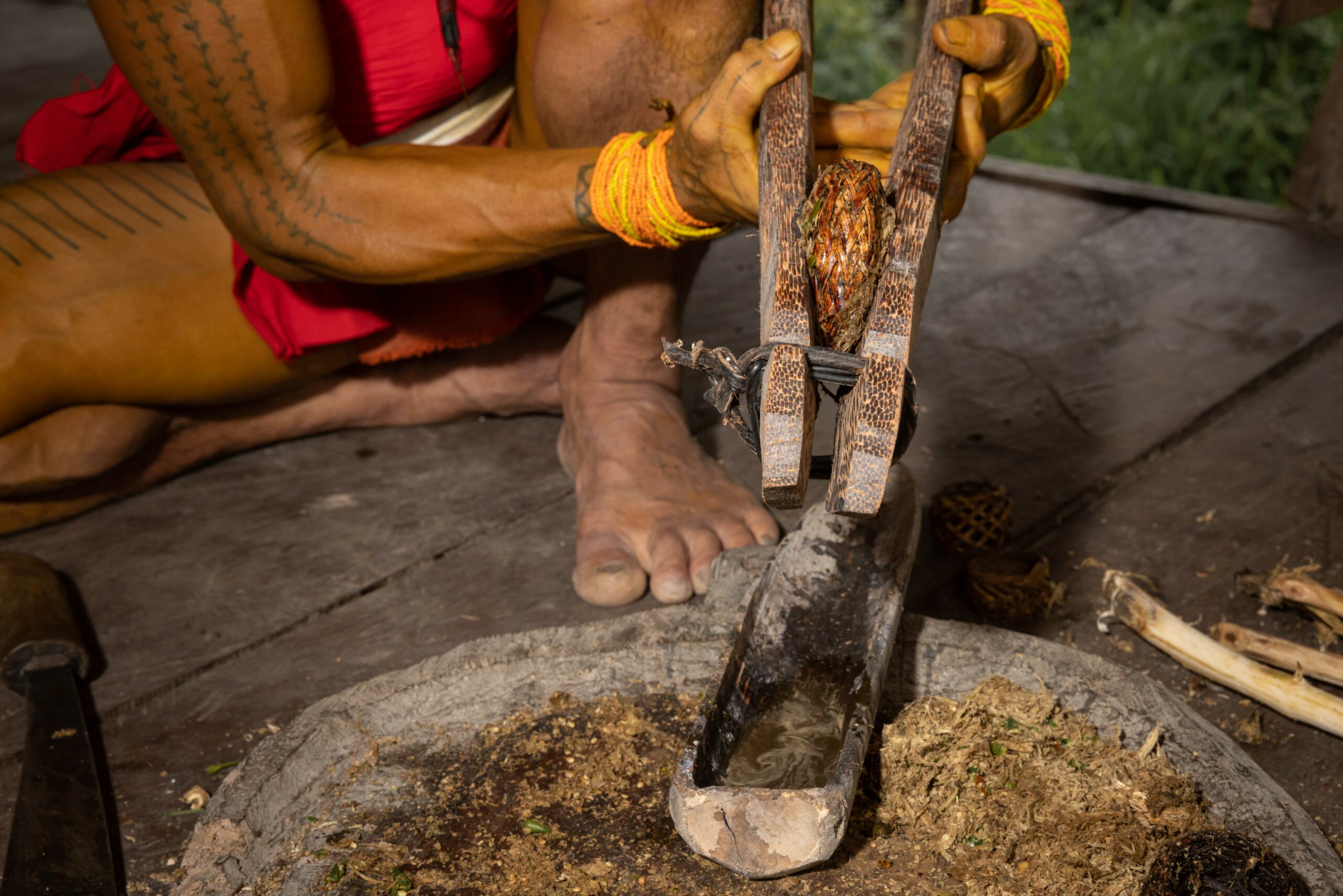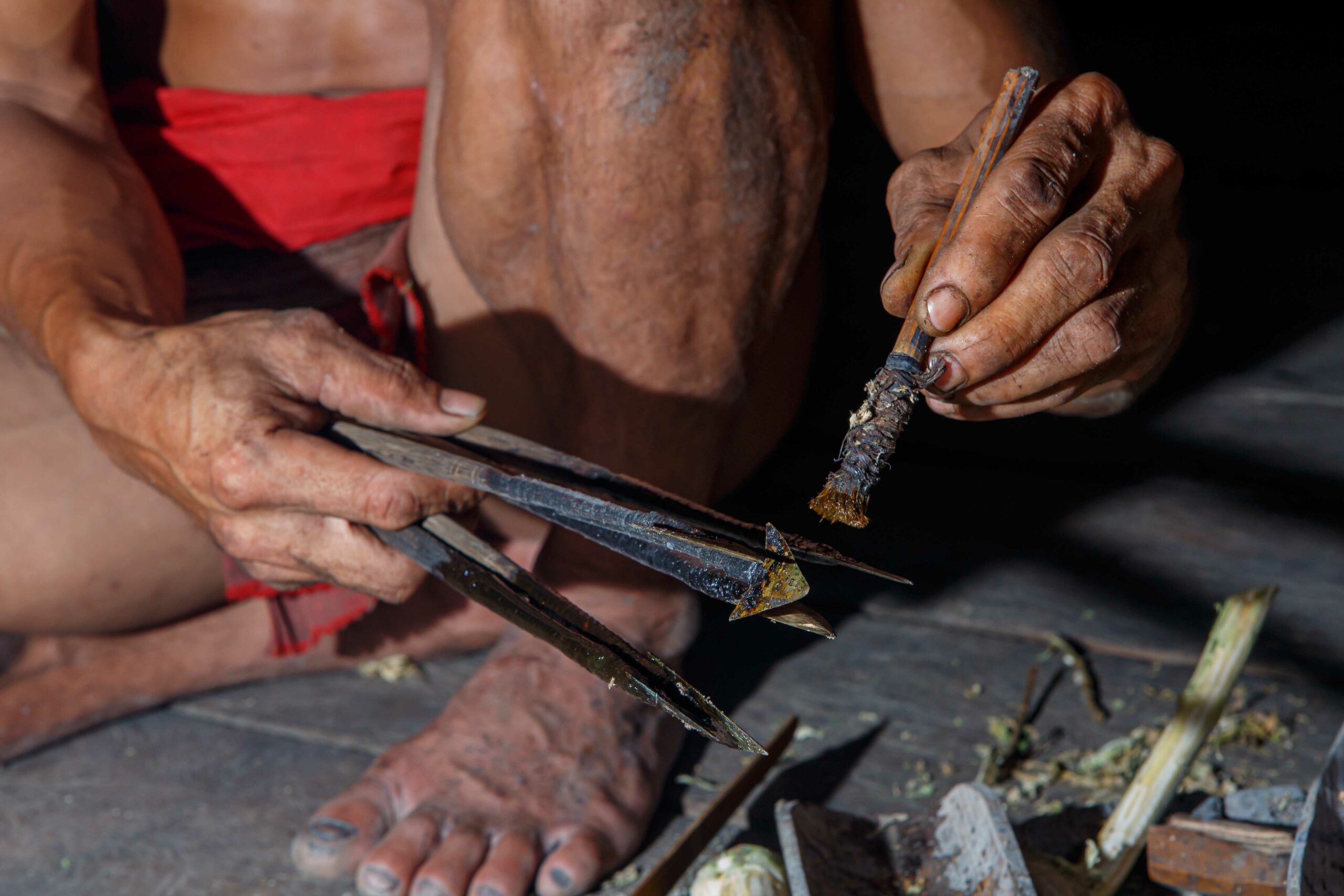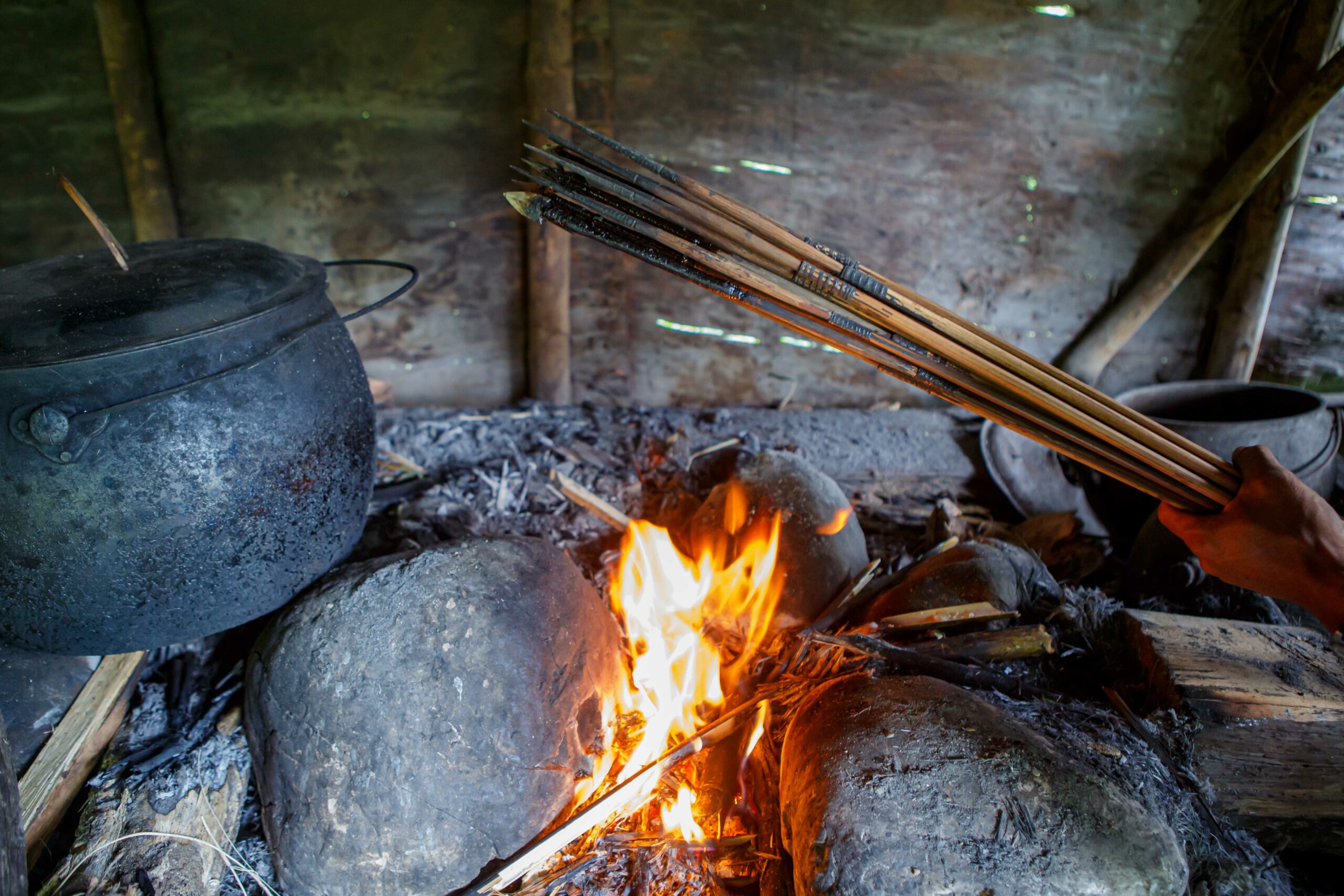The Uma
The Uma – a house
The traditional Mentawai do not live in villages, but in impressive communal houses where up to 10 patrilineal related families might live together. Both these communal houses as well as the related families living there are called Uma.
The umas are built on riverbanks, until deep in the interior of the island, at the edge of the forest where rivers are just small creeks. Usually the extended families of a clan built their uma in the same area, in a small cluster, with each uma at least a few hundred meters away from the nearest neighbouring uma. Different clusters of umas are usually a few kilometers from each other.
Traditionally an uma is between 20 to 30 meters long, 6 to 10 meters wide and about 5 meters high. It is built on stilts, about a meter above the ground. The uma’s roof is made from palm leaves and is reaching almost to the floor. If well maintained, an uma might last up to 50 years, although today’s newer built umas may only last half that age.
The uma is divided in several spaces, each with a different function. At the front of the uma you have the porch: an open platform in front of the actual entrance. Then a large roofed veranda, which is where the Mentawai hang out to socialize with each other as well as visiting guests. Then the entrance to the first and largest interior room, with usually a central fire place.
The front of this first room is almost always open, but can be closed by 3 large hanging doors, which only happens when the entire community is going away for a few days, for instance to attend a ceremony in a far away uma. This largest room is used for the main ceremonies, cooking of sacrificed pigs and chicken and is also where the men, older children and guests sleep. At the back of this first interior room is a single door, leading to the second and smaller interior room, which has 2 open fire pits against the back wall. This room is where most of the meals are prepared and where the women and young children sleep. It is also the room where the most sacred rituals and ceremonies are held. At the back of this second room is another door, leading to a small platform outside, used for washing dishes and other household work. Along the sides of the uma are a few other doors leading to smaller platforms, all used for a variety of purposes.
The Uma – a community
An uma is a small village under a single roof. The members of an uma help each other in their daily lives, in a non-hierarchical community based on solidarity and equality, without any kind of leadership and with equality among men and women. The Mentawai have a strong sense of community and each family is subordinate to this community. Within an uma decisions are made together, in communal meetings.
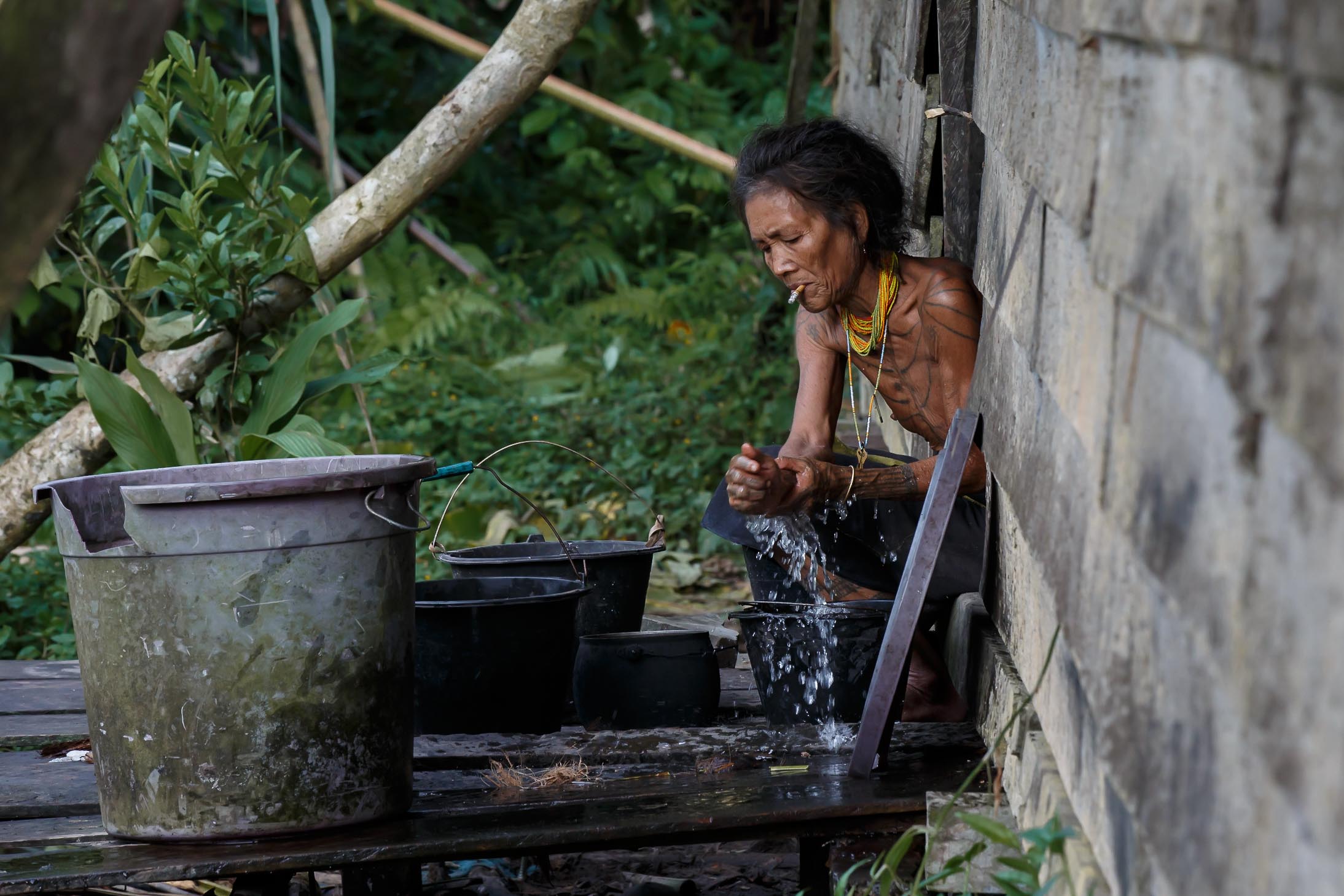 Each household within an uma is in principle self-supporting and man and woman together are able to produce everything needed for a traditional life. As soon as children are old enough they will help their parents as well. The sons inherit the property of their parents, while the married daughters will join their husbands’ uma.
Each household within an uma is in principle self-supporting and man and woman together are able to produce everything needed for a traditional life. As soon as children are old enough they will help their parents as well. The sons inherit the property of their parents, while the married daughters will join their husbands’ uma.
As long as a girl is not yet married her brothers have to take care of her.
For the Mentawai it is not the family, but the local group, the uma, which is the actual unit in which daily life is lived and a lot of work is done together. This is because a single family is simply too limited to manage daily life. For heavy work they often need help from others, and when somebody falls sick or when a parent dies it is almost impossible for the rest of the family to take care of each other. Also children are raised not only by their parents, but all adults in an uma.
Daily Life
Traditionally the Mentawai do not struggle to maintain and support themselves and food is almost the last thing to worry about. They are completely self-sufficient, as they get all they need from their plantations and as hunter-gatherers from the river, the forest and the sea. The island is scarcely populated and most soil is very fertile, which makes growing crops relative easy. Sago, taro and bananas make up their staple food, and is supplemented with the meat of domesticated pigs and chickens and that of wild animals caught in the jungle, rivers and sometimes ocean. The jungle also provides a huge variety of other edible and useful products.
Work-techniques of the Mentawai are simple and food production as well as preparation is uncomplicated and not very work-intensive. The Mentawai do not know specialization in work, although not everybody is as skilled as others in the different kinds of daily work. Work is only defined by gender and evenly divided between men and women. The reason for this gender-related differentiation in work is mainly a matter of the differences in strength. Women also tend to focus more on work in or near the uma, as they also have to look after the children when the men are working further away in the plantations or forest.
As soon as children are old enough they will help their family: the sons will help their older brothers and father, the girls will help their older sisters and mother. Together they produce everything necessary for life.
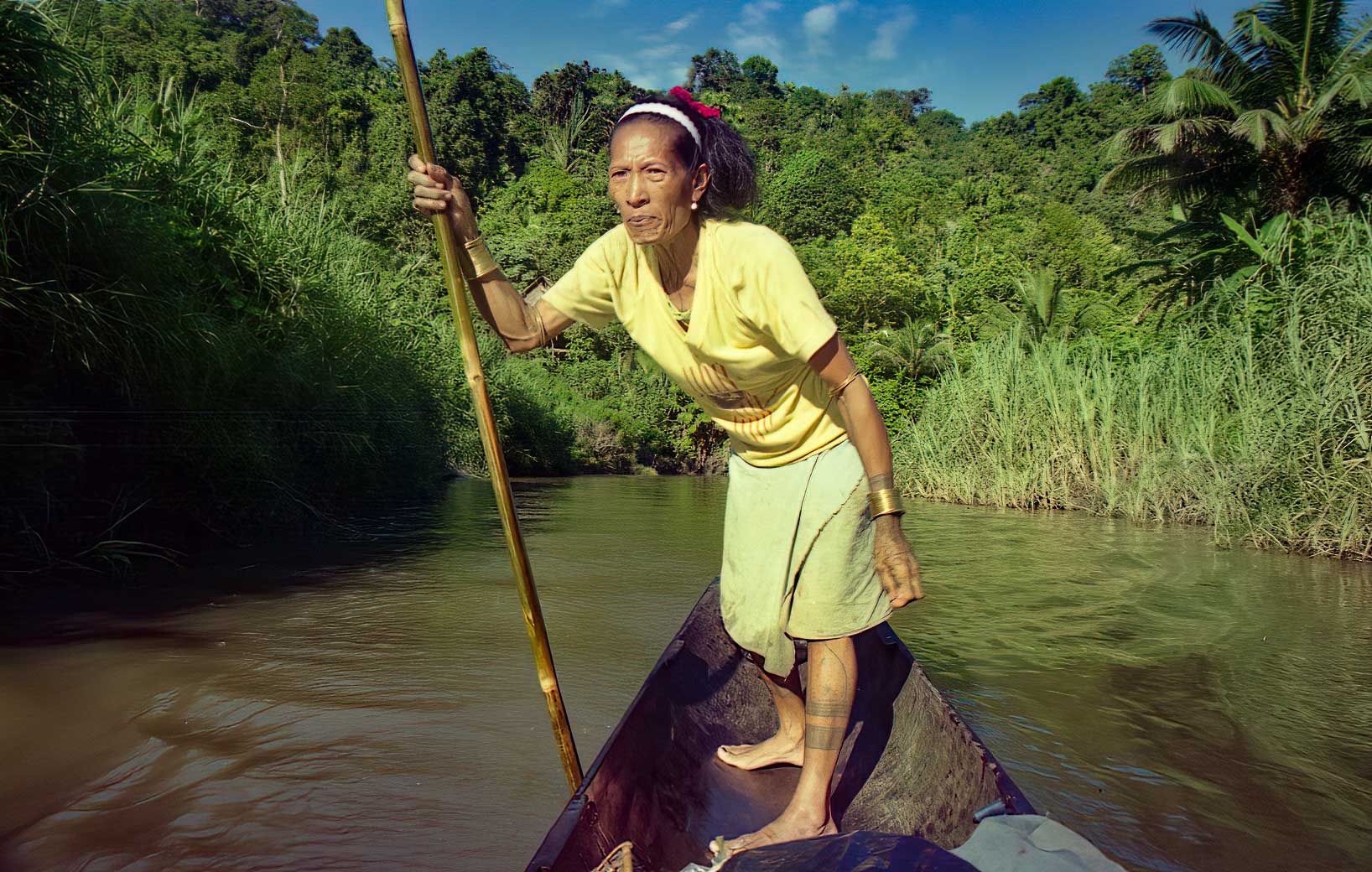 Sometimes the Mentawai visit the coast, in their large canoes, for fishing or trading with settlers from Sumatra or even Java. The Mentawai themselves traditionally never settled along the coast though, as salt seawater flows at high tide up the rivers, making the riverbanks far from attractive for settlement.
Sometimes the Mentawai visit the coast, in their large canoes, for fishing or trading with settlers from Sumatra or even Java. The Mentawai themselves traditionally never settled along the coast though, as salt seawater flows at high tide up the rivers, making the riverbanks far from attractive for settlement.
In the forested steep hills of the interior the only way of transport is by foot, along a network of small, sometimes hardly recognizable trails and countless stream beds. When rivers are large enough the Mentawai use their long dugout canoes (abak) to transport products from the forest or their small plantations back home, and occasionally to the coast to sell or trade. In the lowlands rivers are almost the only arteries used for transportation of both goods and people, as large coastal areas in the east are covered by mangrove or swamp, making any form of land transport almost impossible.
Agriculture
Upstream from the Mentawai settlements, where rivers get smaller and land more hilly and forested, the Mentawai exploit the forest and lay out their agricultural fields, small plantations. Each family within an uma has its own fields and this is also where they have their own small house, the sapou, where they raise their pigs and chickens.
After a few years, when the soil of a plantation is losing fertility, they plant fruit trees. Where used to be rain forest they create their own new production forest, from which they can harvest more food than from the original rain forest. Further inland these production forests give way to almost unspoiled tropical rain forest. The Mentawai use these original forests only extensively, for collecting firewood, trees for their canoes or houses, rattan and occasionally they go there to hunt for wild game: pigs, deer or monkeys.
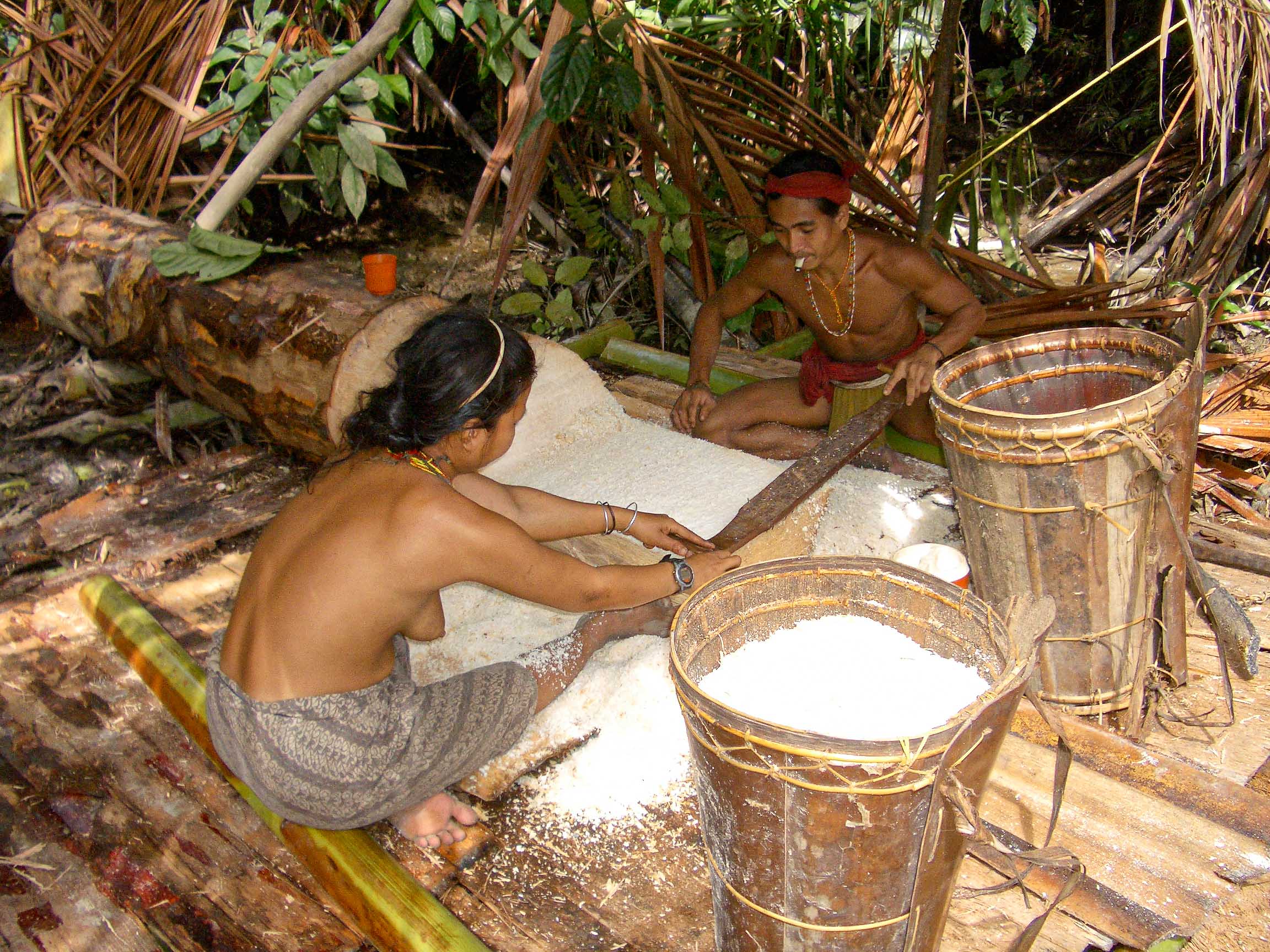 The main staple food of the Mentawai is sago, flour from the grated stem of sago palms. Sago palms are growing in patches in the swampy marshland, called mata: ‘eyes’. Each patch of palms has an owner; either he who planted the first young sago palms of the patch or he who got the patch through heritage or as gift.
The main staple food of the Mentawai is sago, flour from the grated stem of sago palms. Sago palms are growing in patches in the swampy marshland, called mata: ‘eyes’. Each patch of palms has an owner; either he who planted the first young sago palms of the patch or he who got the patch through heritage or as gift.
A sago palm needs at least ten years to become fully grown. The swamps where the sago palms grow are very fertile, because of a continuous supply of minerals from the little streams from the hills or regular flooding. Sago palms produce their own young shoots, so if a sago patch is well maintained it effectively can produce food for decades. The entire process, from planting young palms to the actual making of sago-flour is mainly men-work and done in these swamps.
First the palm is felled and the very hard bark is opened and pealed off with machetes and a large palm wood chisel. Then the soft core of the sago palm is grated with a large wooden rasp with nails. The raw sago pulp is collected in large baskets and then processed in what I call a small ‘one-person-sago-flour-factory’ (pasirereat): a large sieve built on stilts above an artificial small pond in a small creek. The sieve is traditionally made of bamboo and the fibers of palm leave shafts.
The sieve basket is filled with raw sago pulp and one of the men will then stand in the sieve, repeatedly scooping water from the pond with a kind of bucket attached to a long pole, pouring the water over his thighs while rhythmically stamping around through the pulp. Quite a unique sight, almost like a dance!
The water, with the dissolved fine sago-flour, drains through the sieve into an old dugout canoe. The sago-flour then slowly deposits at the bottom of the canoe, while excess water slowly flows over the edge of the canoe. After a few days the flour is collected and then stored in meter high cylindrical containers, made of sago palm-leaves tied together with rattan. The containers with sago-flour are then stored under water, where the flour remains good for months.
Sago-flour is one of the world’s most time-efficient staple foods to process. It takes the Mentawai about 5 days to process a fully grown sago palm, and the palm can produce up to 500 kilo of dry flour. For an ordinary family this is enough for a couple of months. Usually, different families cooperate in the processing of sago and the flour is then shared.
A sago palm or parts of it can be used in many other ways. Sometimes a sago palm is felled and then split open along the entire stem. The soft core of the palm is then accessible for the sago-beetle (tamara), which lays her eggs inside the sago. A month later the Mentawai then collect the thumb-sized larvae of the sago-beetle from the half-rotten palm. These grubs are very rich in protein and eaten alive, boiled or roasted.
The leaves of the sago palm are also used to make atap for the roofs of the uma, while the shaft of the leaves are used to make suitcases (bakulu), baskets and sleeping-mats.
Another important food-source for the Mentawai is the root of the taro. Taro is grown in the muddy wet fields close to the rivers, usually close to the uma or a sapou. The taro fields and the entire process from planting to harvest is the women’s domain of work and every women has her own taro field, sometimes a few. To protect the taro against pigs the fields are surrounded by a large natural fence. After each harvest the soil is plowed and then planted again. The fields can be used years on end, as they are naturally fertilized by flooding rivers or streams.
At the higher land around the taro fields, where the soil is more dry, different species of banana trees, other root-crops and sugarcane are grown. All these crops are planted and harvested throughout the year and do not depend on any season.
Banana trees are planted on the dry banks of the rivers as well, by both men and women. A banana field does not require much maintenance work and a fence is also not necessary. Older trees produce young shoots and a banana field can be productive for many years.
New fields for agriculture are prepared in the forest by a man and his wife together, usually not far from their sapou. First they clean the ground from the lower vegetation and small trees. Then usually young banana trees and sweet potatoes are planted, between the remaining trees of the forest. After these crops start to grow the remaining trees of the forest are felled. In contrast with other tribes in Asia which practice slash and burn techniques, the Mentawai do not burn the vegetation or felled trees, as this is considered a waste. Instead, they let it decompose.
When the leaves and other green of the cleaned vegetation and felled trees are decomposed they plant additional crops, such as a kind of taro that grows in dryer soil, tapioca, papaya, chili, turmeric and sometimes pineapple, cucumber, tobacco and plants used for making poison for the hunt. Once the banana trees grow big enough and produce sufficient shadow, seeds of slow growing fruit trees are planted, for instance durian, jackfruit, rambutan, lemon and others.
Over the next few years the family can harvest and replace the ‘dry’ taro, tapioca, fast growing fruits like pineapple and papaya, but over time the soil gets exhausted. Then the Mentawai do not plant new crops anymore and only look after the slow growing fruit trees. Some of these fruit trees start to produce fruit within a couple of years, but durian for example only after ten years or more. The plantation has now changed into a new kind of productive forest (mone), from which the family can regularly harvest the different kinds of fruits for many years to come.
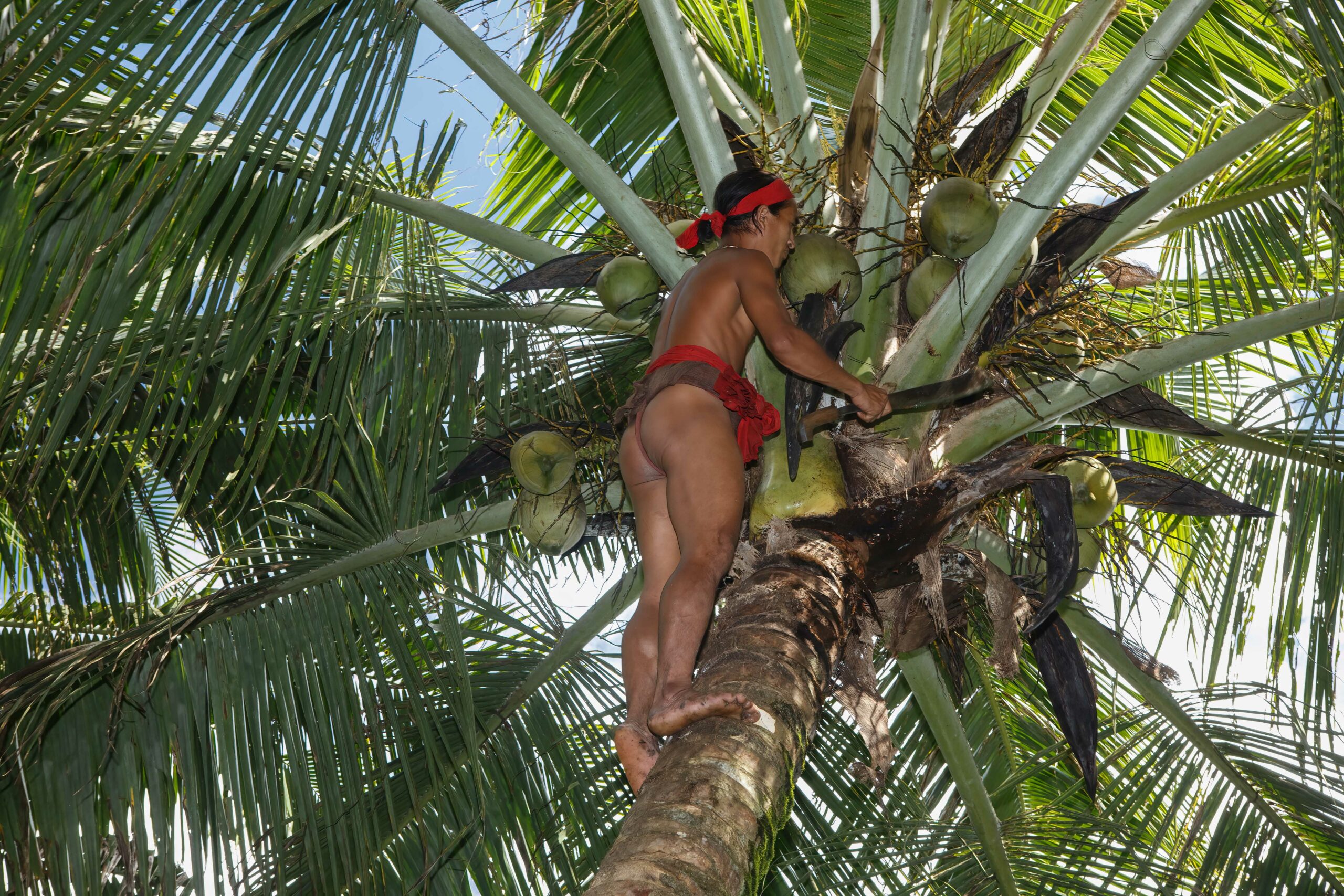 Another daily Mentawai food item is grated coconut. Men grow coconut palms on the dry river banks near their sapou, but also far away up or down stream the river.
Another daily Mentawai food item is grated coconut. Men grow coconut palms on the dry river banks near their sapou, but also far away up or down stream the river.
On Siberut each coconut palm has an owner and the same rule as for other fruit trees counts: if you are traveling and are thirsty you can take a coconut, but it is a serious crime if you harvest with the intention to bring back home or sell.
Stealing coconuts used to be one of the major crimes on Siberut, because coconuts were excellent to barter or sell to settlers in the harbors, to obtain for example iron tools, glass beads and fabrics. Nowadays more forest products are sold in the harbor, like rattan and bananas.
The Mentawai use the coconuts also for other purposes. From the nut they make spoons and they used to make a traditional tobacco container, which they hung around their waist with a piece of rope. From the fibers of the coconut peal they make thick rope, used for fishing nets that are used at sea. This rope is also used for carrying their bugbug, a bamboo tube in which the men keep their poisonous arrows for the hunt.
Livestock and Pets
The Mentawai breed chickens for the meat and for sacrifices. Especially during large ceremonies dozens of chickens are sacrificed. Chickens are rarely kept for the eggs alone, because the Mentawai see that as a waste: each egg produces another chicken, resulting in more eggs than the one where the chicken came from…
Chickens are usually kept at the sapou of the family, or dedicated chicken shelters. The chickens are regularly moved from one to another sapou, so they are able to find fresh food and also to make it harder for predators such as snakes to find them. During the day the chickens are left to roam free, looking for their own food. Each afternoon chickens with chicks are locked up in a rattan basket and are fed grated sago and coconut. In the morning they are fed again and then released.
The most important livestock for the Mentawai are the half domesticated pigs. They are mostly left to roam free, but at least every few days the pigs are additionally fed with sago, either near the uma or a sapou. Feeding the pigs is, as for the chickens, done by both man, his wife and the older children.
The pigs give birth in the forest and are not kept separate. Within a month the piglets start to eat independently.
Pregnant female pigs usually bite and chase away the boars and when the majority of females are pregnant the free roaming boars might run away to other feeding sites to find more females or, more dangerous for the owner of the pigs, to the pigs of another uma or even search for a wild herd of pigs. The Mentawai have an effective solution to avoid this: when most females are pregnant, all the present boars are castrated. Castrated boars don’t run away anymore, and another advantage is that these boars become more fat and grow up to eighty kilos. As young male pigs become sexual active within a year there is never a shortage of reproductive males.
Pigs fulfill an important position in the spiritual world of the Mentawai and breeding pigs is therefore surrounded with taboos. When a female pig is visibly pregnant, up to the moment the piglets start to eat independent, it is for instance taboo for the owners of the pigs to plant crops, have intercourse or be deloused.
Pigs are also the most important asset for the Mentawai and having many pigs increases an uma‘s prestige in the valley. Special guests for instance, can be welcomed with the preparation of a young pig. The adult females and large castrated males are solely reserved for communal celebrations and ceremonies of the community. Each time pigs are sacrificed all relatives and friends living in umas nearby receive meat as well, all in equal portions. The more meat, the higher the prestige of an uma.
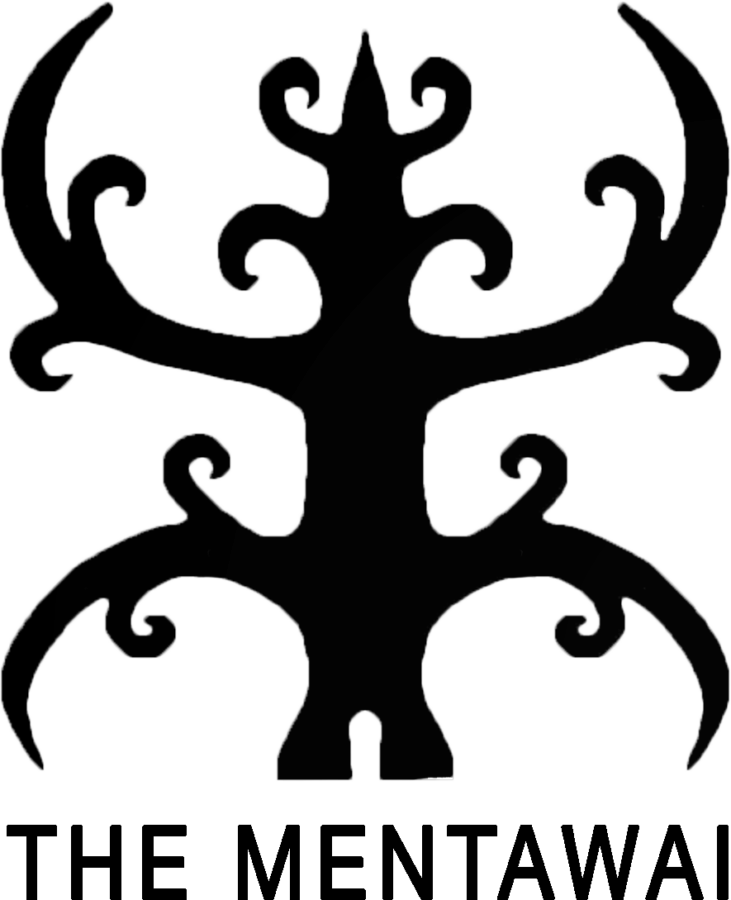
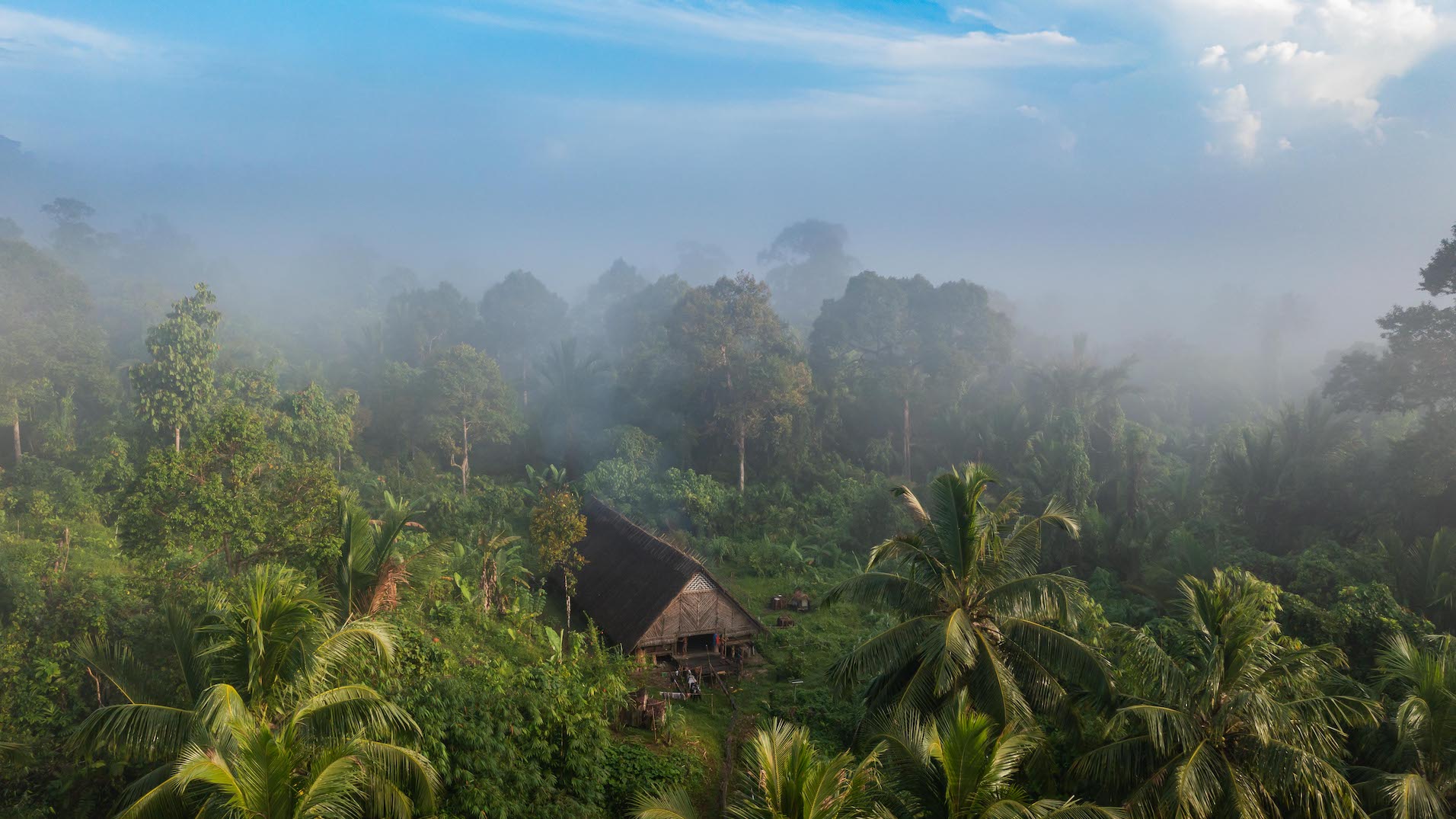
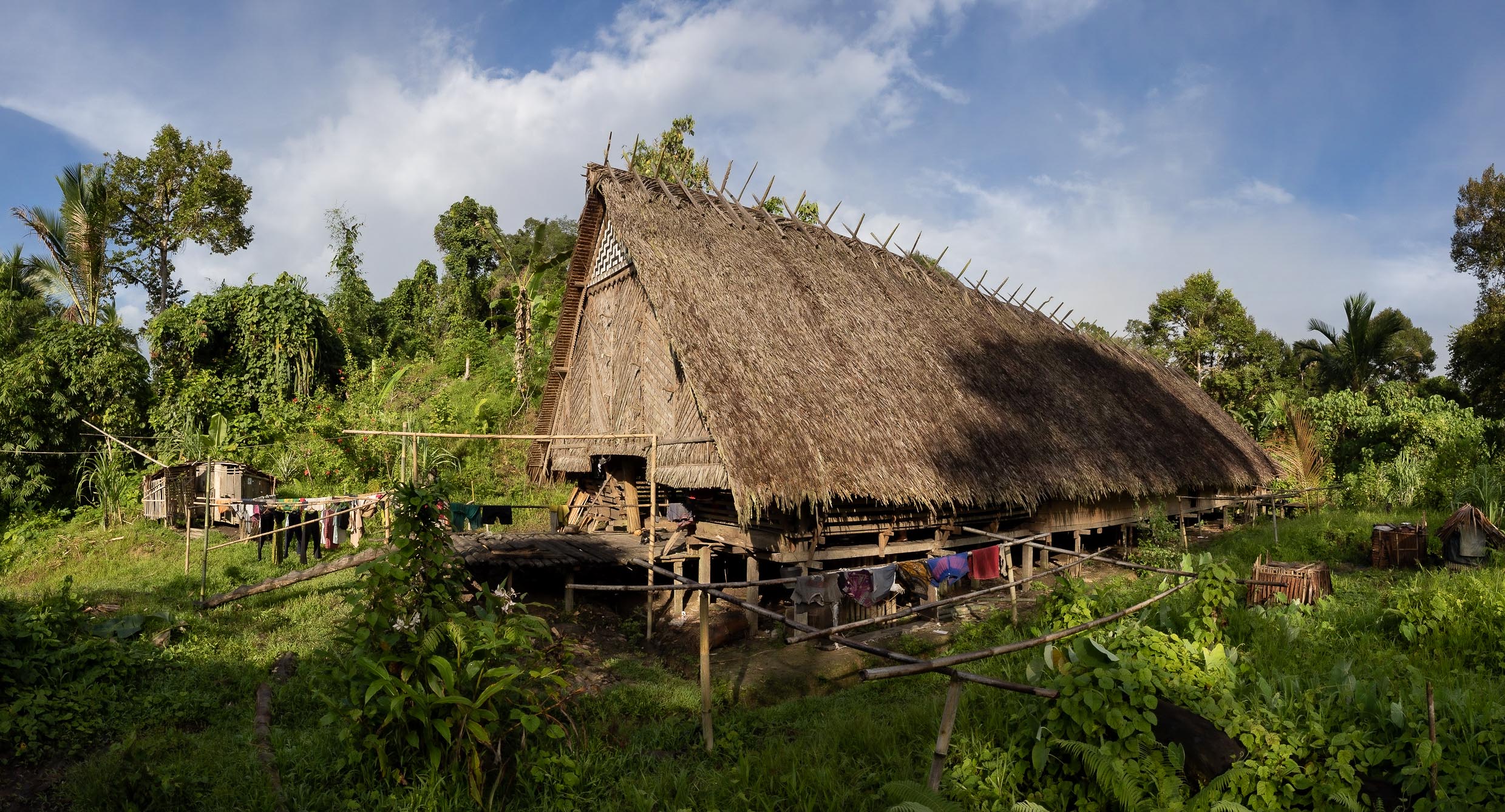
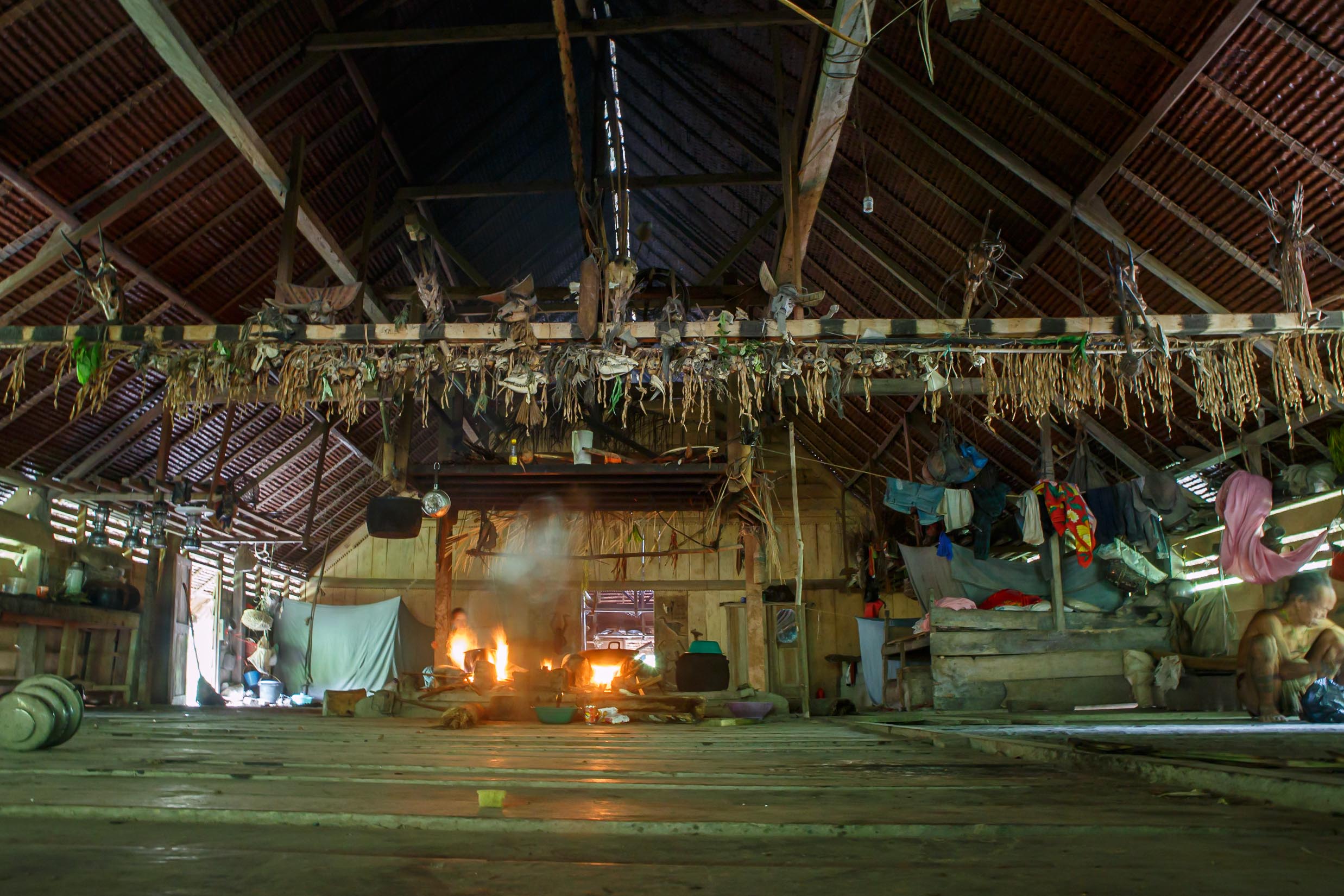
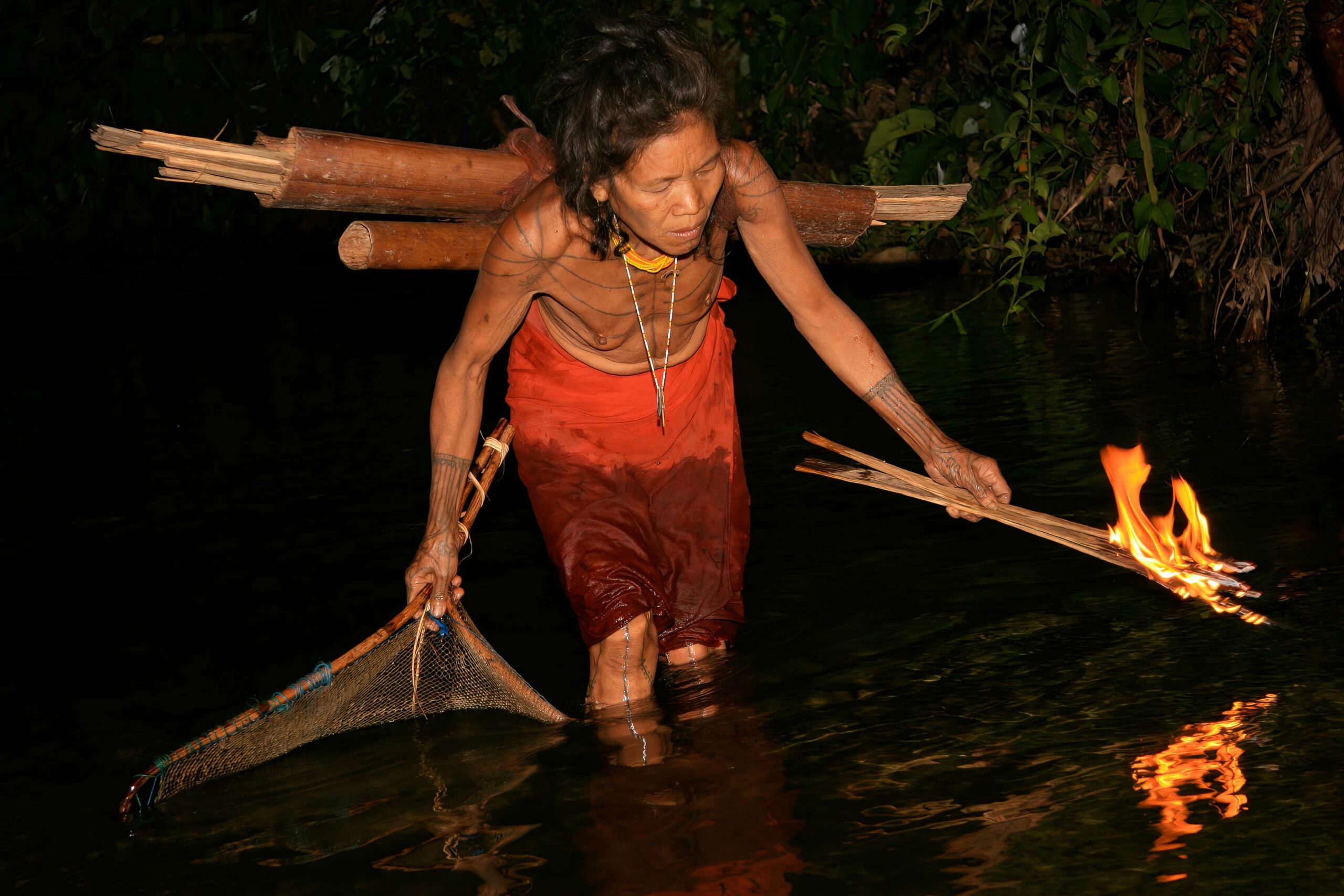
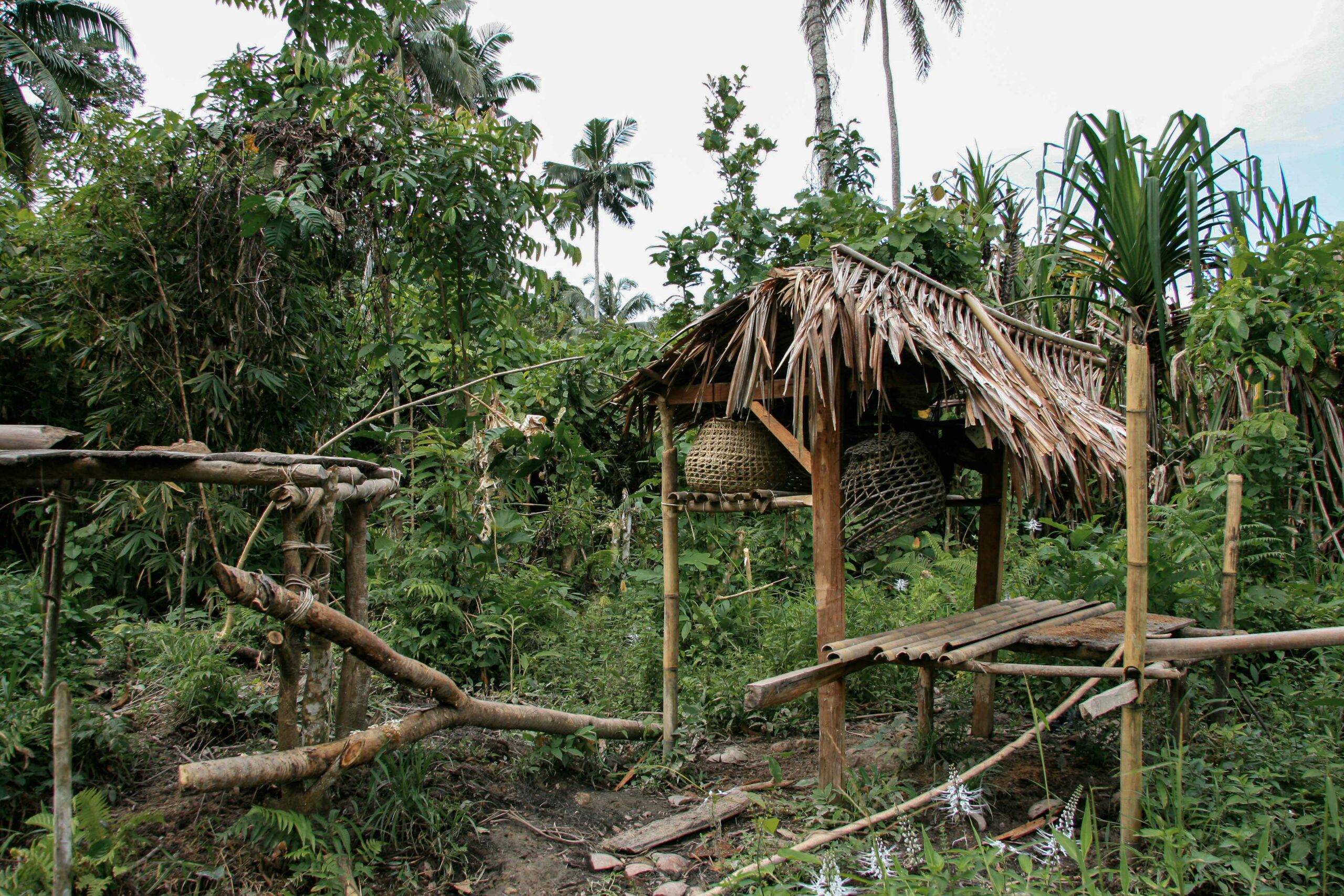
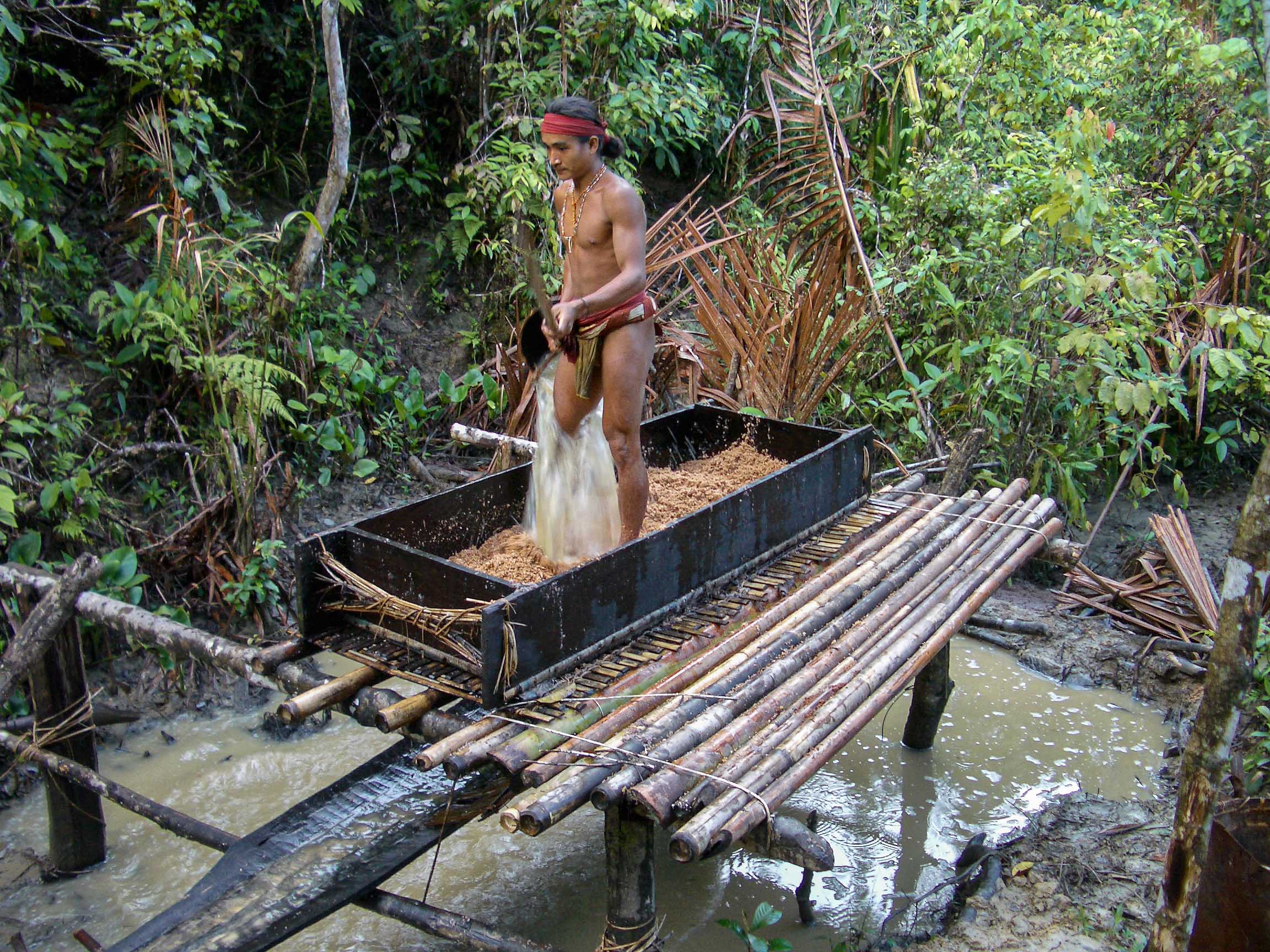
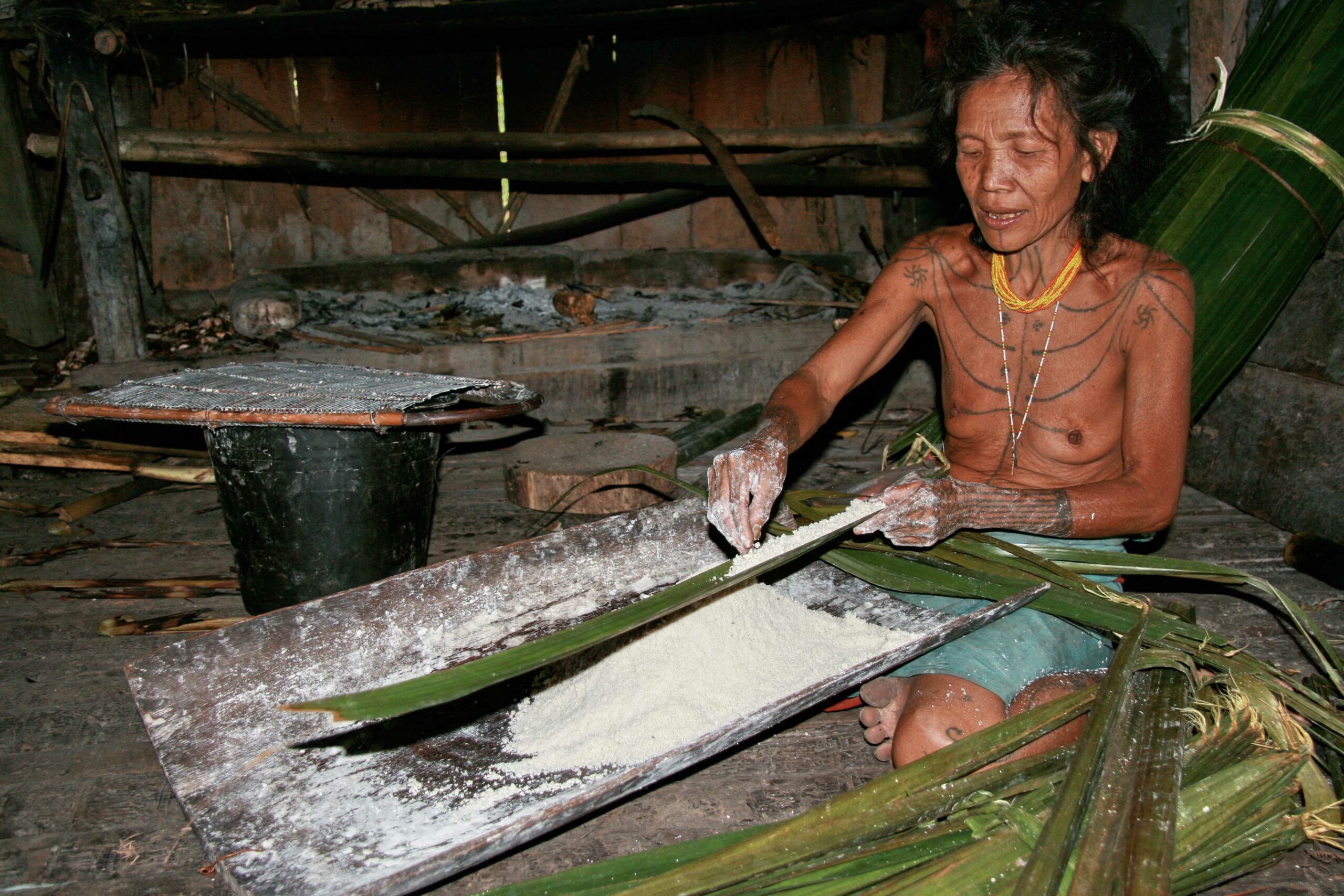
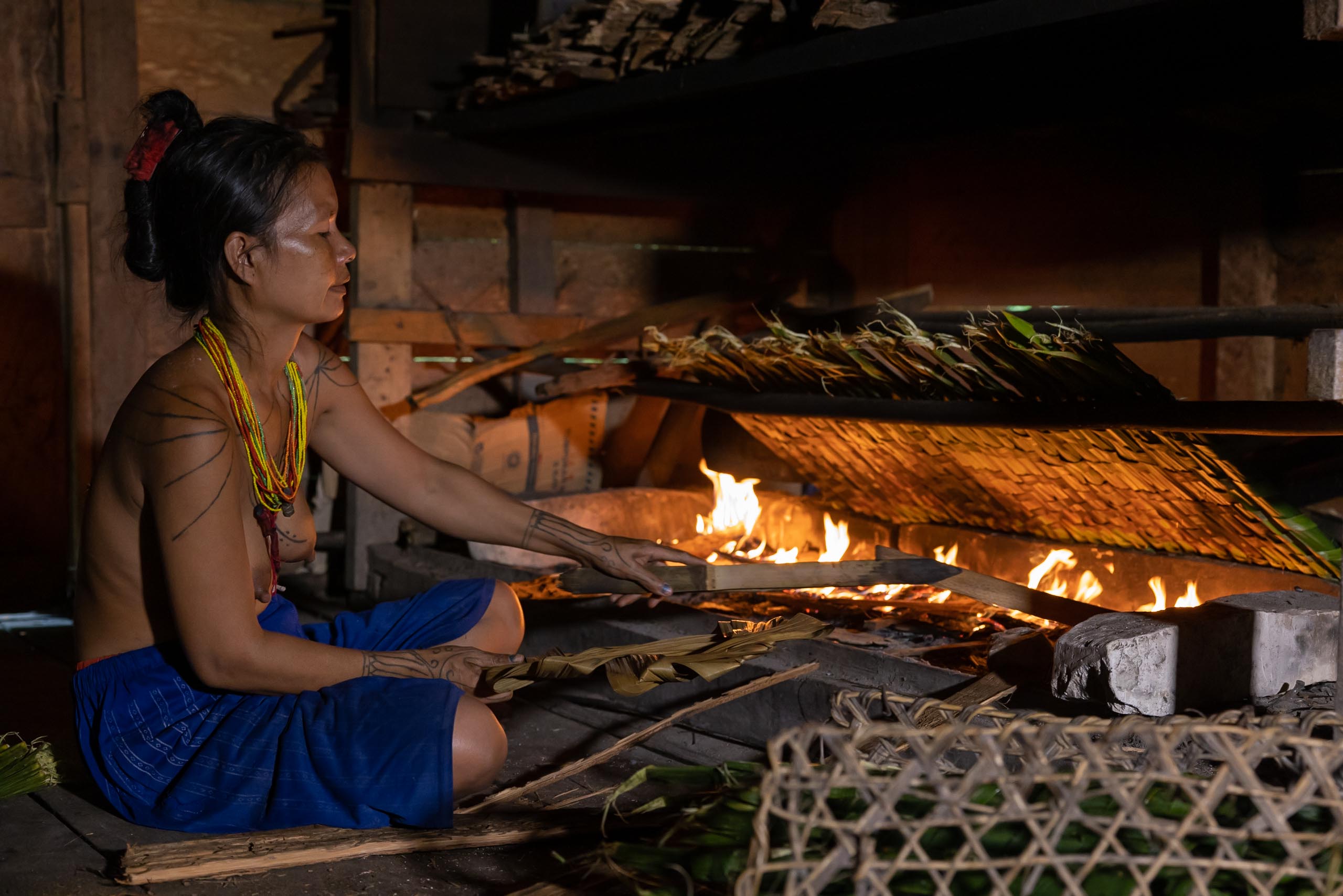
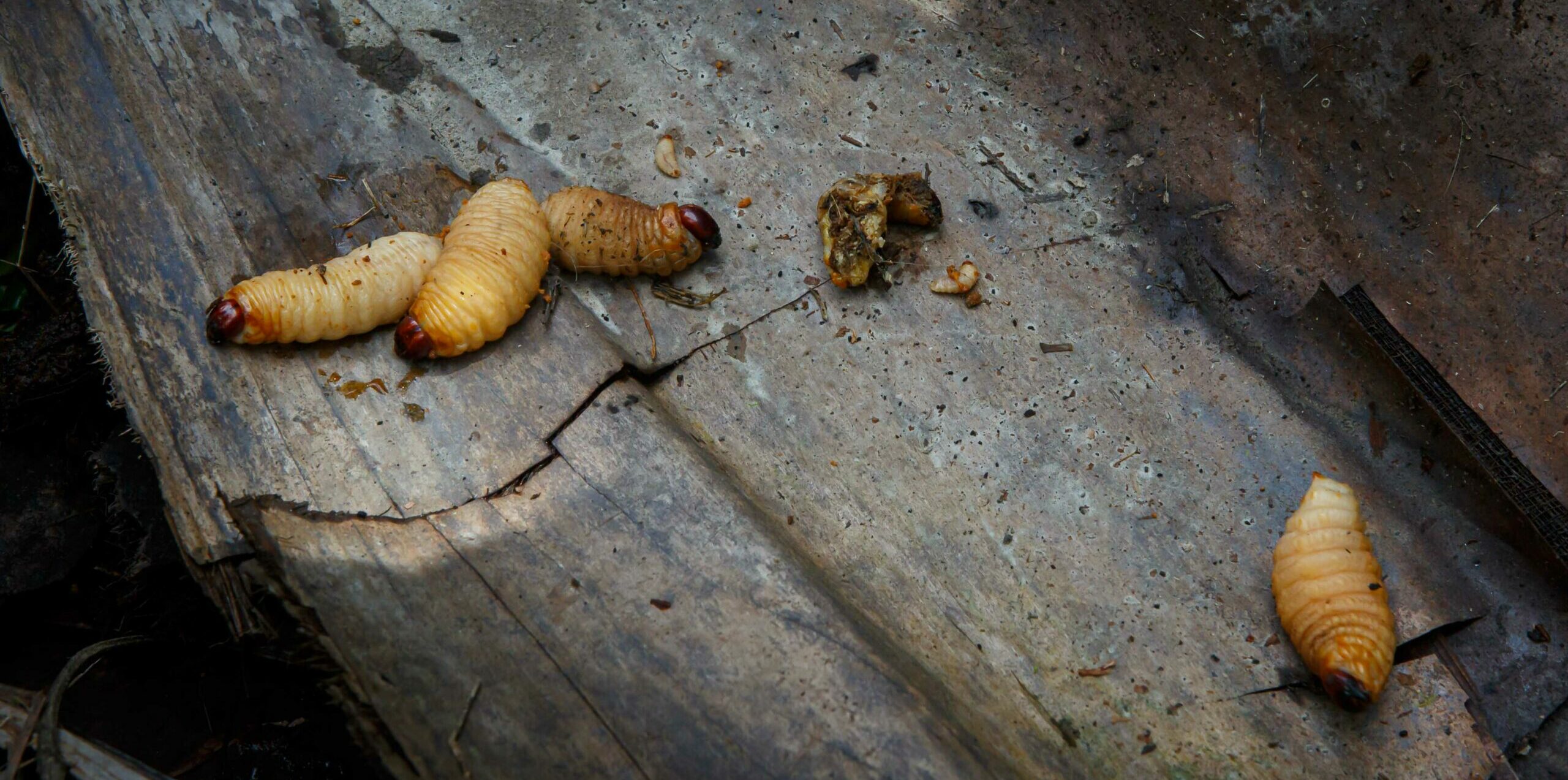
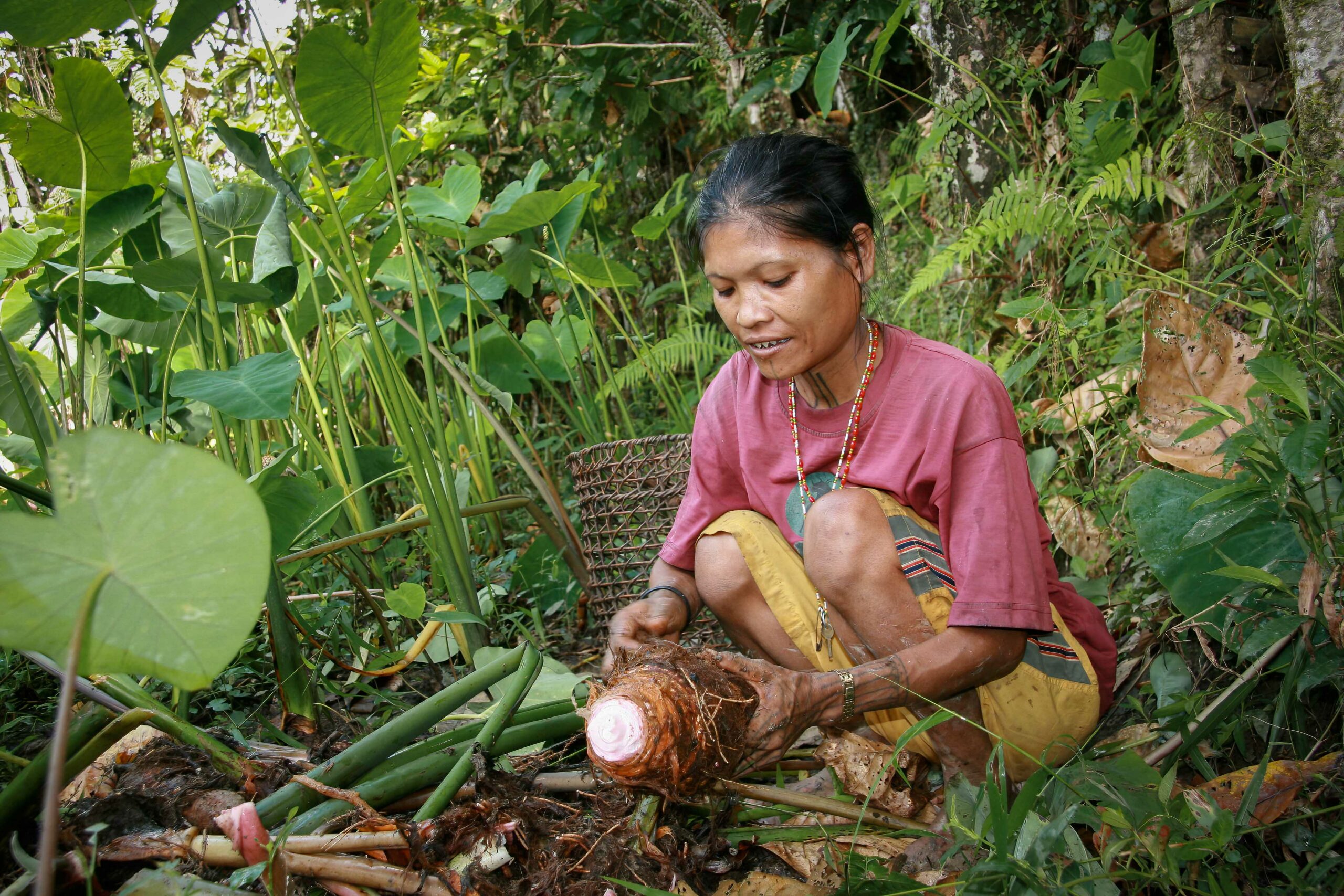
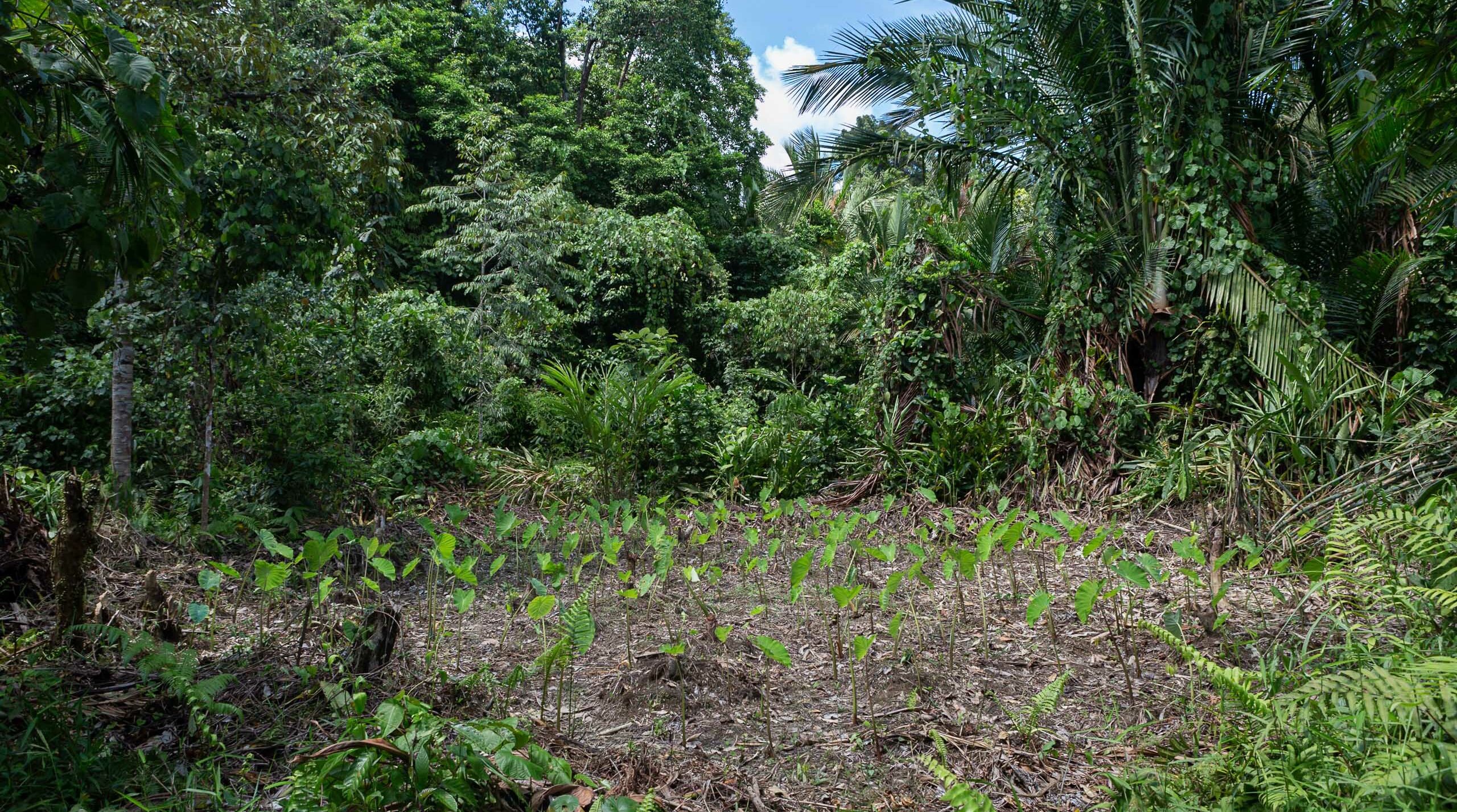
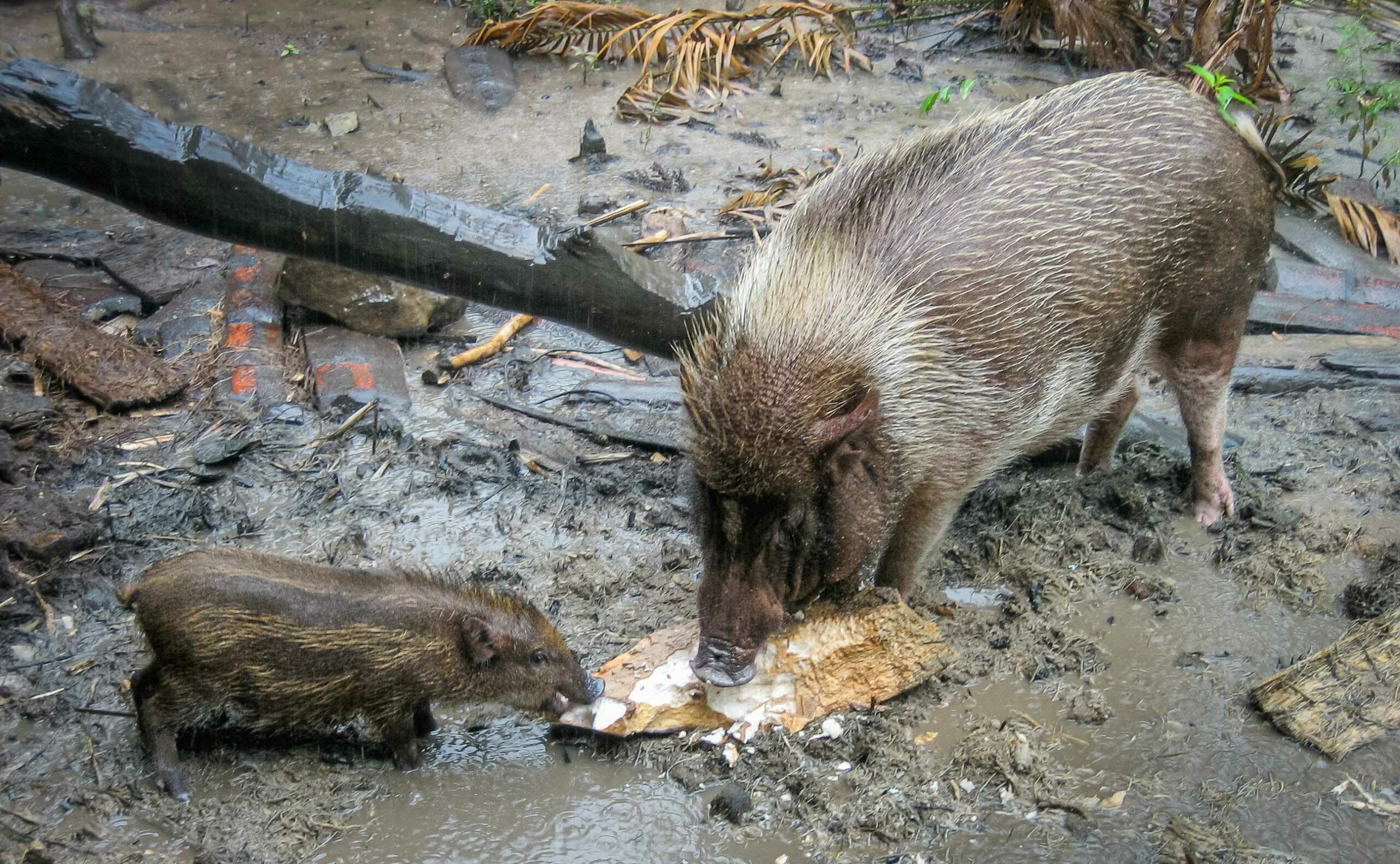
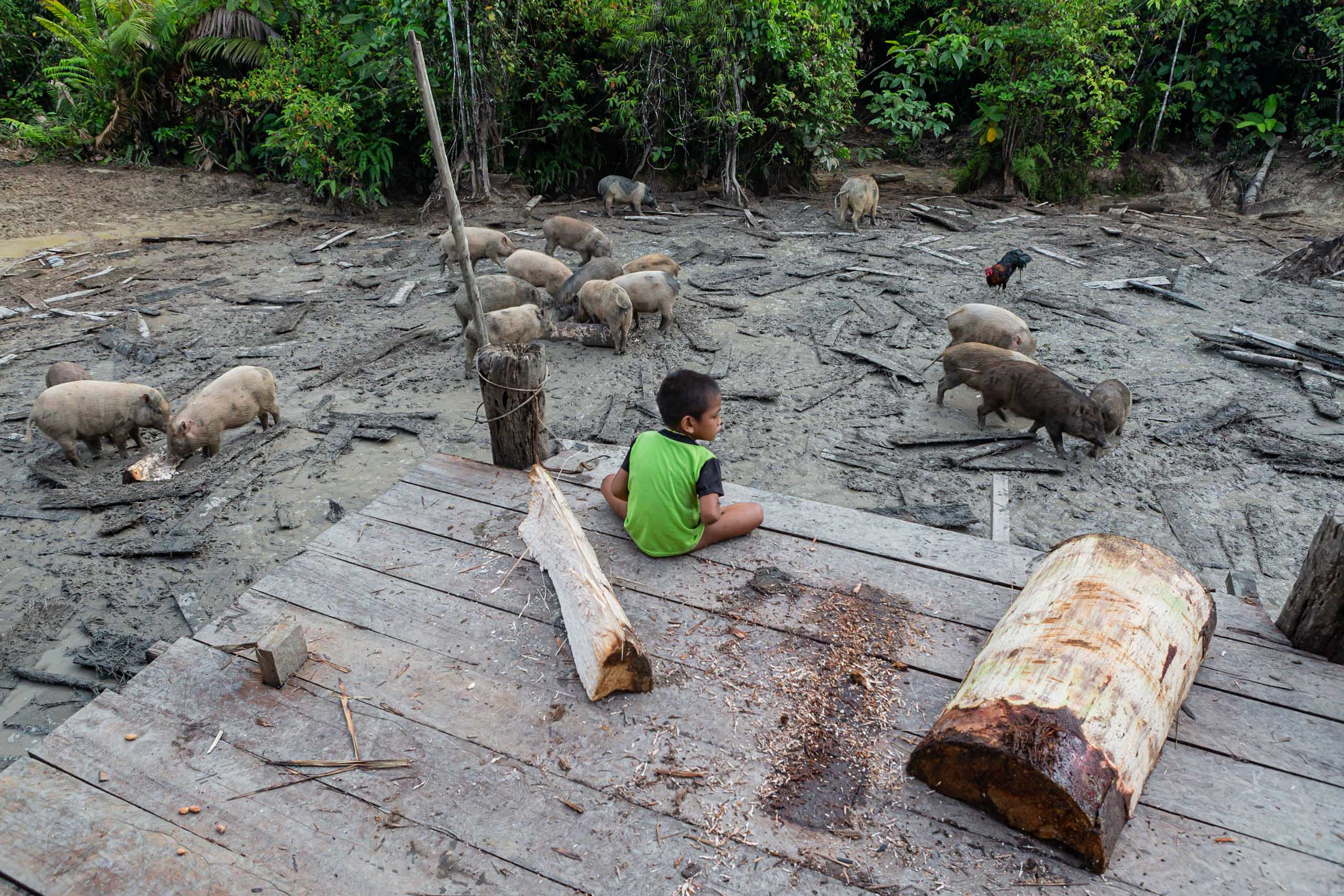
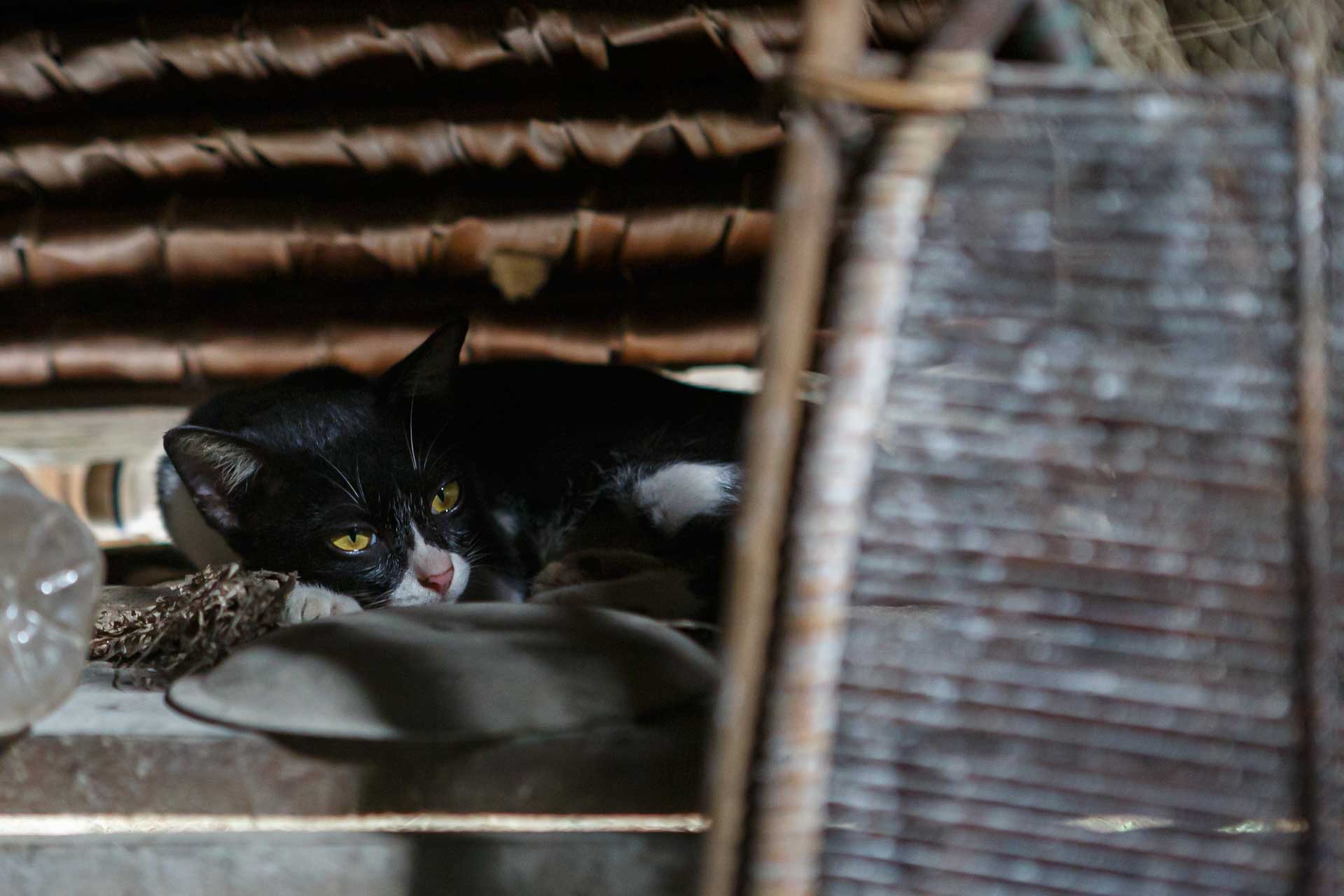 Other pets that are held are dogs and cats, probably introduced by early traders.
Other pets that are held are dogs and cats, probably introduced by early traders.